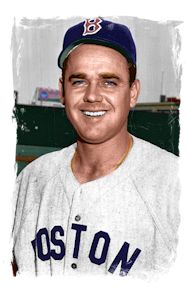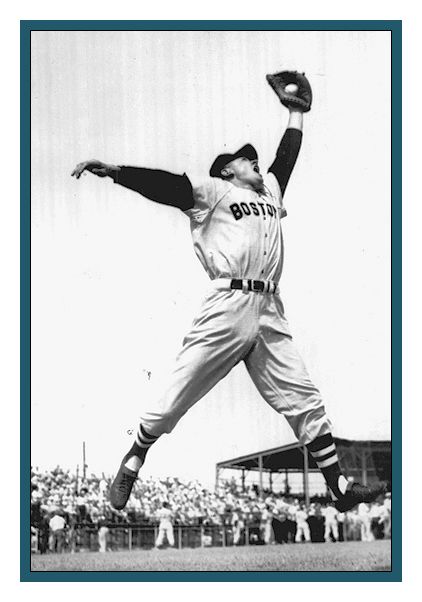|
“FENWAY'S BEST PLAYERS”  |
|||
Allen Lee Zarilla was born on May 1, 1919 in Los Angeles. Like many boys, young Allen learned to play baseball in the neighborhood sandlots. While still at Jefferson High School, the 17-year-olda caught the attention of Chicago Cubs scouts at a tryout camp in Los Angeles. He was one of 18 selected to play against strong semipro teams in the area. When he broke his left ankle sliding into a base the first season, the Cubs’ interest waned. The Browns signed him for a few hundred dollars. In the spring of 1938, and Al was sent to San Antonio, Texas, where five Browns farm teams were training. None of the teams wanted him and he was then sent to Palestine, Texas, with the same result. Al ended up with the Batesville (Arkansas) White Sox in the Class D Northeast Arkansas League. He did not disappoint, hitting .329 and leading the league in runs, doubles, and total bases. For the 1939 season, Al was in Louisiana playing with the Lafayette (Louisiana) White Sox of the Class D Evangeline League. Al was back in Arkansas for the 1940 campaign but this time with the Helena Seaporters of the Class C Cotton States League. He parlayed a stellar 1940 season into a promotion the next year to the Class B Springfield (Illinois) Browns in the Three-I League. He spent only 25 games there before the call-up came from the Class A1 Texas League San Antonio Missions. He stayed with the Missions for the 1942 season as well and struggled the entire year. He repaid the confidence shown in him by hitting a gaudy .373 in his first 57 games with Toledo Mud Hens in 1943. The parent club took notice and the depleted Browns called upon him to make his major-league debut on the last day of June. He appeared in 70 games for the sixth-place team and hit .254. When the ’43 season ended, Al went home to Los Angeles, where he worked at a “war plant,” Western Pipe and Steel Company, as he had the previous offseason. Additionally, he played exhibition games in the California Winter League, an integrated professional league that dated back to 1910. The CWL was made up of Negro League teams, sometimes Negro League all-star teams, and major-league all-star teams. He was having a good season at the plate until baseball commissioner Kenesaw Mountain Landis put an end to the festivities. Landis ordered all the major-league players participating in the CWL to quit playing, invoking a rule against playing exhibition games more than 10 days after the World Series had been completed. His next season, 1944, was a special season for the Browns. After spending most of their existence at or near the bottom of the American League, the Brownies captured the pennant in ’44. The ever hustling, high-energy Al was not a starter at the beginning of the season but earned the status as the season wore on. His baseball career was put on hold when Uncle Sam called him into the Army. He reported to Fort MacArthur in San Pedro, California, in October 1944, and then was moved to Fort Warren, near Cheyenne, Wyoming. He served for the duration of the war and then reported to the Browns’ spring training camp in Anaheim, California, in February 1946. With the war over, the star players returned to their major-league teams and the Browns were back to their usual position in the standings. Als statistics declined in ’46 and he was now a starting outfielder for the seventh-place Browns. After starting off reasonably well he, had a terrible year at the plate. Clearly, this downward trend could not continue or he would find himself back in the minors. After the ’47 season, he played in the California Winter League. He put everything together and had a breakout season in 1948, finishing at .329, fourth-best in the American League. He was voted in to play in the All-Star game. His 1948 performance earned him a few votes among sportswriters for the MVP, the only time he was so honored. After a “substantial” raise in pay and a bit part in the movie The Stratton Story during the offseason, Alwas back with the Browns to start the 1949 season. He would not be there for long, however. In May, as the last member of the 1944 pennant-winning Browns still with the team, he was traded to the Boston Red Sox. He may have been thrilled, but he was over-anxious as well, getting off to a slow start with his new club. Then, in May hit his first homer with Boston. Bu June, he was the regular right fielder for the 1949 Red Sox. In September 1949, Al had a three-run inside-the-park home run to help the Sox defeat the A’s. It was the first inside-the-park homer at Fenway Park since 1931. He had a good season for the Sox, hitting .281 with 32 doubles, 9 homers, and 71 RBIs in 124 games. He was solid in right field as well with six assists and just four errors in 251 chances. The Red Sox were an offensive juggernaut in 1950. Al was a big part of the attack, hitting .325 in his first full year with the club. The Sox need to shore up the pitching in 1951 and it meant a change of uniforms for Al before the season. The Red Sox had Billy Goodman, winner of the 1950 American League batting crown, ready to play right field, which made Al expendable. In December 1950, the Red Sox traded him to the Chicago White Sox for pitchers Ray Scarborough and lefty Bill Wight. Al batted .257 with the White Sox. The following season, he had a slow start and in June was traded to the Browns and was to be back with his original team for only 48 games. At the end of Auguat, the Red Sox, who were trying to make a move on the Yankees, purchased his contract for the waiver fee. He finished the season with the Red Sox, but overall, he had his worst year in the majors, hitting .225 with little power and just 24 RBIs in 104 games. After the season, for years he worked as a “grip” in the offseason at Columbia Studios, and got his second chance to appear in a feature film when he landed a bit part in the Grover Cleveland Alexander bio-pic The Winning Team, starring Ronald Reagan and Doris Day. Now 34, Al relegated to the bench for 1953, his last season in the big leagues. He got into only 57 games for the fourth-place Red Sox. He batted just .194with 4 RBIs and played in his last major-league game in September, and was given his release the following January. Like many players of his era, he went to the Pacific Coast League when he could not get a position in the majors. In 1954, he signed to play the outfield with the Seattle Rainiers. He played in the PCL in 1955 as well but only on a limited basis. The Chicago Cubs hired him to manage their Class C affiliate, the Magic Valley (Idaho) Cowboys in the Pioneer League for 1956. The Cowboys came in fourth in the eight-team circuit and Al had 20 at-bats in 11 games, getting seven hits (.350). After his playing days were over, he worked at scouting and coaching. In December 1957, the Kansas City Athletics announced that they had signed him as their scout for Southern California. He remained a scout with the Athletics until September 1961, when he and five other A’s scouts quit, citing disagreements with the operating policies of new owner Charlie Finley. He scouted for the Cincinnati Reds from 1962 through at least 1968. In October 1970, he became a full-time scout in California for the Washington Senators. After the All-Star Game in 1971, he became a coach for the Senators, enabling him to accrue the 90 days of major-league service he needed to double his pension. In 1972, Al moved to Hawaii, where he was a part-time scout for the Major League Scouting Bureau and, by 1978, the first-base coach of the Hawaii Islanders of the Pacific Coast League. In later years, he was often seen at Aloha Stadium and later Rainbow Stadium. On Aug 28, 1996, in Honolulu, Al Zarilla succumbed to cancer at the age of 77.
|
|||

